AMD's A10-5750M Review, Part 2: The MSI GX60 Gaming Notebook
by Dustin Sklavos on June 29, 2013 12:00 PM ESTSystem and Futuremark Performance
There's a lot of information that we can cull from our standard suite of system benchmarks when it comes to the MSI GX60 in its stock configuration. We can place its performance against the last generation GX60, featuring an almost identical configuration save a theoretically slower APU, we can determine how much of a performance hit there is from only having single-channel memory operation, and we can get an idea of how much performance is getting left on the table by using an AMD A-series APU instead of an Intel i7 quad core CPU.
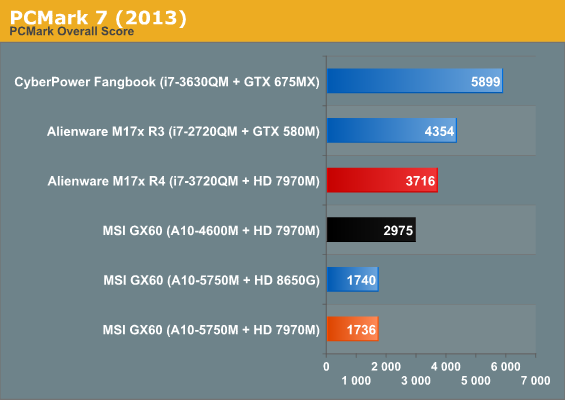
PCMark 7 will always favor systems with SSDs, so there's not a whole lot to learn here unless you compare the GX60 with the 7970M to the IGP and dual-channel memory (listed as the A10-5750M + HD 8650G). On the CPU side there's either almost nothing lost, or the 7970M is picking up slack.
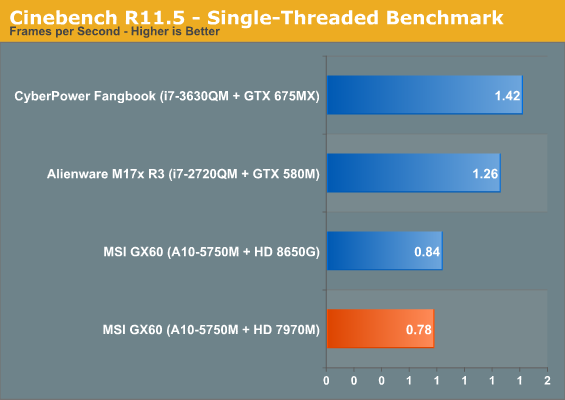
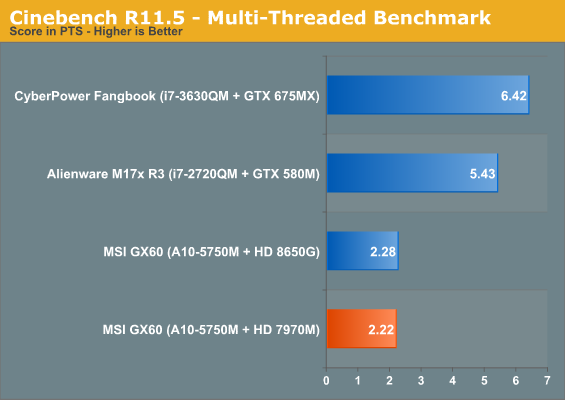

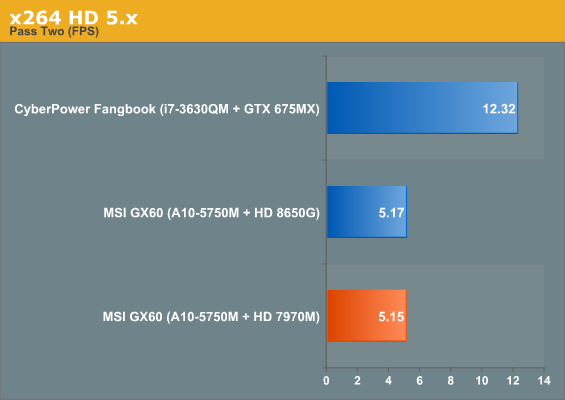
MSI was right in that the single-channel memory operation doesn't really impact the GX60 in CPU-isolated tasks. It's consistently slower, but just barely so. Unfortunately we also get to see just how rough the drop down to an A10-5750M from an entry-level Ivy Bridge quad core really is; the i7-3630QM is never less than twice as fast as the A10. It's true that the i7 is rated to draw ~30% more power, but it gets at least 100% more performance.
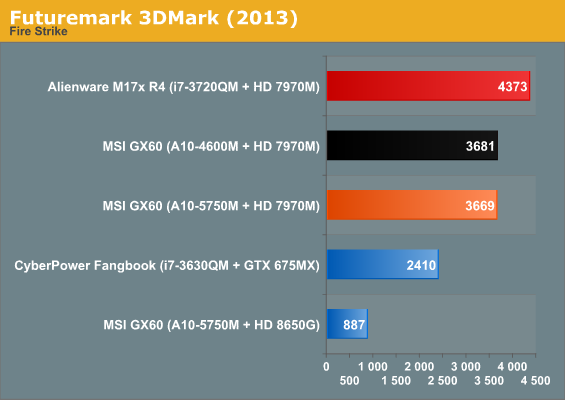
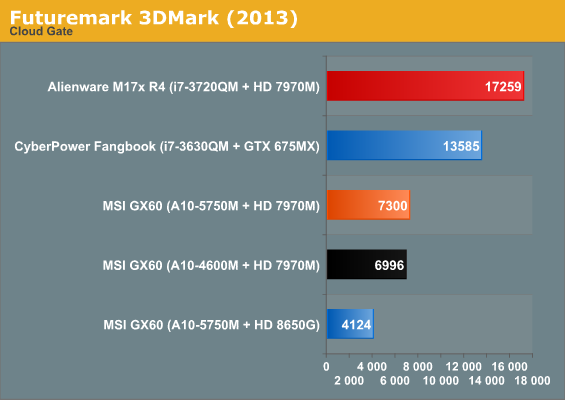
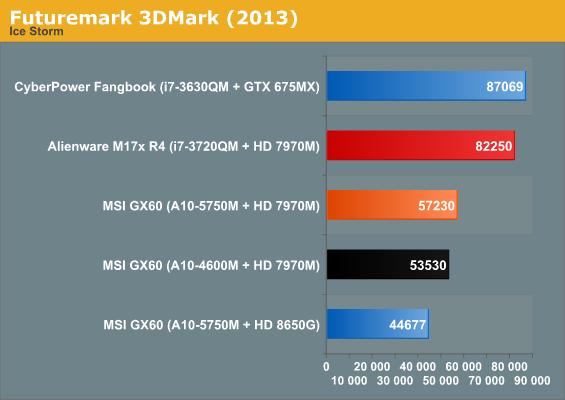

Even when trying to isolate GPU performance with 3DMark, it's pretty clear the AMD APU is holding back the Radeon HD 7970M. The newer generation GX60 is able to eke out a fairly consistent, measurable lead over its predecessor, but a substantial amount of the 7970M's performance is clearly being left on the table. I'd say the 7970M is just too much GPU for the A10-5750M, but unfortunately AMD doesn't have any good substitutes for the 7970M/8970M; the 7870M and 8870M are both based on Cape Verde, which has half the GCN cores and memory bus width the Pitcairn-based 7970M/8970M does. And there's no 7950M/8950M based on the cut-down Pitcairn used for the desktop 7850, nor even any mobile chips based on Bonaire (HD 7790).
This highlights a glaring hole in AMD's mobile lineup; NVIDIA's only using the GK104 in their top end chips (GTX 680M and 780M), but they have the beefy GK106 to fall back on. Bonaire needs to make its mobile debut in a hurry.










69 Comments
View All Comments
Sabresiberian - Saturday, June 29, 2013 - link
People can talk about how games don't need powerful CPUs all they want, but the fact is, there IS a minimum requirement, and some games DO make use of the top end CPUs available. The more powerful your GPU, the more powerful the CPU needs to be to allow it room to work.This MSI notebook is built using one of the reasons I don't buy pre-built desktops, cutting corners on one part to spend money on another. It's bad design, it doesn't work (at least when the corners are cut to this degree), it makes for a system that is built cheap and shows it in its performance. Shame on MSI, they know better (or at least some of them do - maybe those people aren't in the notebook division).
"Balance" is the key to computer design, just as it is with many things in life.
Dustin Sklavos - Sunday, June 30, 2013 - link
For a while it was true, games by and large didn't really need powerful CPUs. Over about the past year or two that changed and changed *dramatically.* You're getting games that have a tremendous amount of complexity to them; graphics are practically the least of Skyrim's engine's worries, Crysis 3 has an incredibly rich and vibrant environment (despite being kind of crappy), and Tomb Raider is no different. It looks like TressFX takes its pound of flesh out of the CPU *and* the GPU.j_kut - Saturday, July 6, 2013 - link
Skyrim, Crysis3 and Tomb Raider run all maxed out on the GX60 except for 4*MSAA.Only Games not running smooth on this system are MMOs where the CPU is needed for all characters on-screen.
Being a GX60 owner myself I can totally recommend it, except you wanna play GW2 or similar stuff.
YukaKun - Sunday, June 30, 2013 - link
Where's the battery test with just the iGPU like you guys did with the i7?We need those numbers for bragging rights :P
Cheers!
JarredWalton - Sunday, June 30, 2013 - link
Battery testing is done with the dGPU inactive via Enduro, so these are the "best-case" battery life results for this particular notebook.Khenglish - Sunday, June 30, 2013 - link
I know that on optimus systems that the dGPU will still draw a little bit of power even when off. The motherboard still keeps the Vin line active, although the GPU core and memory VR's shut down. I tested this with a multimeter. The fact that the card is still visible to on the pci bus means it's still drawing a little power.It's probably only like half a watt, but it's something.
JarredWalton - Sunday, June 30, 2013 - link
Last I heard from AMD and NVIDIA, it's not even half a watt -- more like 100mW or something in that range. But until we get a system that only has a Richland APU with no dGPU, we can't really test what battery life is like. The GX60 is also a large system relatively speaking, so I'd expect a less performance oriented laptop to get much better battery life with Richland -- same goes for Haswell and IVB laptops.silverblue - Tuesday, July 2, 2013 - link
There's something else that needs to be addressed, if at all possible...The first GX60 had exceptionally poor CPU performance as evidenced by your article eleven days back. From your conclusions, you didn't think that it could have all been down to the CPU (perhaps Enduro was to blame?). So, have MSI fixed that with the second gen GX60, or are we just seeing a (pardon me) turd with go-faster stripes? One or two of the part 1 tests actually underperformed the Trinity prototype which was interesting.
A comparison between both GX60s would be an eye opener.
kwrzesien - Tuesday, July 2, 2013 - link
I'm ready for another page: GAMING PERFORMANCE PART 2Add (or replace) the HDD with an SSD and replace the memory with 2x4GB 1866MHz RAM. Rerun all tests and compare the incremental cost to the more expensive Alienware models. I would argue that the best memory and a good SSD with greatly improve the lags in CPU performance and free the dGPU to perform closer to an i7. Definitely not going to catch it, but closer...
Wolfpup - Tuesday, July 2, 2013 - link
This continues to be an intersting system. I wish AMD would put out a higher end mobile CPU. Since their A series is roughly 50/50 CPU/GPU, there's no reason they couldn't dump the GPU portion and replace it with another 4(ish) cores, and/or clock things higher with a 45 watt TDP.